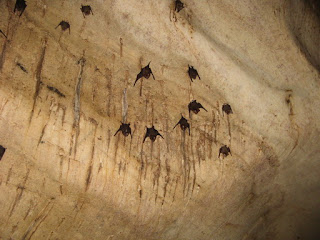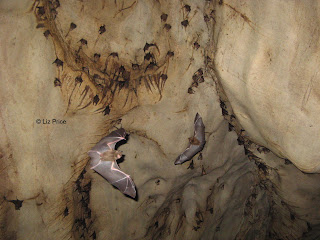Gua Kajang is a short tunnel cave through the hill Bukit Kepala Gajah, at Lenggong in ulu Perak.
The main entrance
View from the other end
A local Malaysian film, Sifu dan Tongga, was partly filmed in this cave in 2009. They left behind a bamboo platform.
The area is an archaeological site, first dug in 1917 although it was visited much earlier in 1876.
To the right of the main entrance of Gua Kajang is a short cave full of bats.
cricket
Gua Kajang register number Prk 64/04.
See more on 3d scanning in Gua Kajang .
© Liz Price
No reproduction without permission
Pictorial blogs on some of the interesting caves I have visited around Southeast Asia. On some blogs I have included photos taken over the years.
Although this blog was only born in 2011, I have now included older posts from my Multiply blog which closed in March 2013. This includes articles I have written. I am now also adding news relating to caves I have a particular interest in.
See my website on Caves of Malaysia.

sign in a cave in Laos
29 September 2011
23 September 2011
Perak Tong after the 2009 rockfall
Perak Tong is one of Malaysia's most famous cave temples, located north of Ipoh.
In Jan 2009 there was a disastrous rockfall there, which killed one person. Although the tragedy was covered for several days in the press, there was no mention of what had really happened, or suggestions as to the cause.
The collapsed area can be seen from the road. It covers a much larger area than I expected.
Statue at the base of the stairs.
In August 2009 I managed to visit the cave for the first time since the rockfall. The cave was already "back to normal" in the sense that the staircase up through the cave to the top of the hill had been rebuilt.
This pillar wasn't damaged
There is now a new staircase up through the cave to the back entrance. This area is now much brighter as the top chamber (presumably where the collapse occurred) now allows a lot of light to enter. As we left the chamber with the 3 large statues, on the left we saw 2 new pillars which seemed to be supporting a massive rock.
Hong translated the Chinese writing and said the pillars had just been constructed, that summer. I was stunned - were these pillars meant to hold up the rock, or were they just for 'decoration'.
As we neared the top, we could see parts of the old staircase - white block on top is remains of old staircase wall, tilted.
This huge boulder appears to have fallen.
Looking down, presumably this huge boulder fell down
From here it looked as if there were 3 enormous rocks which had moved, but they are so large, I couldn't believe that the place has been rebuilt and reopened in around 6 months. One man told Hong that these 3 rocks had moved, but were now wedged naturally in place. We could see a lot of fresh cement joining and covering various rocks.
Looking down
Inside the main cave construction work was ongoing.
Damaged statue base on right
New floor in front of damaged statue
Unfortunately I have no photos taken prior to the collapse of the inside of the affected areas of the cave, so cannot compare my photos of before and after. But I remember some of the statues that were missing, such as the big laughing Buddha.
However there was no obvious sign of what happened and most visitors will probably remain unaware of the rockfall.
I was quite stunned at the enormity of the collapse - although of course I am not 100% of what actually happened. I really wonder how safe the place is now, have the huge boulders already stabilised themselves....? What are they actually resting on....? I heard unofficially that no proper safety check was done as it would have been too expensive.
---------
Perak Tong register number Prk 34/02.
See more on Peratk Tong murals and Perak Tong views.
© Liz Price
No reproduction without permission
In Jan 2009 there was a disastrous rockfall there, which killed one person. Although the tragedy was covered for several days in the press, there was no mention of what had really happened, or suggestions as to the cause.
The collapsed area can be seen from the road. It covers a much larger area than I expected.
Statue at the base of the stairs.
In August 2009 I managed to visit the cave for the first time since the rockfall. The cave was already "back to normal" in the sense that the staircase up through the cave to the top of the hill had been rebuilt.
This pillar wasn't damaged
There is now a new staircase up through the cave to the back entrance. This area is now much brighter as the top chamber (presumably where the collapse occurred) now allows a lot of light to enter. As we left the chamber with the 3 large statues, on the left we saw 2 new pillars which seemed to be supporting a massive rock.
Hong translated the Chinese writing and said the pillars had just been constructed, that summer. I was stunned - were these pillars meant to hold up the rock, or were they just for 'decoration'.
As we neared the top, we could see parts of the old staircase - white block on top is remains of old staircase wall, tilted.
This huge boulder appears to have fallen.
Looking down, presumably this huge boulder fell down
From here it looked as if there were 3 enormous rocks which had moved, but they are so large, I couldn't believe that the place has been rebuilt and reopened in around 6 months. One man told Hong that these 3 rocks had moved, but were now wedged naturally in place. We could see a lot of fresh cement joining and covering various rocks.
Looking down
Inside the main cave construction work was ongoing.
Damaged statue base on right
New floor in front of damaged statue
Unfortunately I have no photos taken prior to the collapse of the inside of the affected areas of the cave, so cannot compare my photos of before and after. But I remember some of the statues that were missing, such as the big laughing Buddha.
However there was no obvious sign of what happened and most visitors will probably remain unaware of the rockfall.
I was quite stunned at the enormity of the collapse - although of course I am not 100% of what actually happened. I really wonder how safe the place is now, have the huge boulders already stabilised themselves....? What are they actually resting on....? I heard unofficially that no proper safety check was done as it would have been too expensive.
---------
Perak Tong register number Prk 34/02.
See more on Peratk Tong murals and Perak Tong views.
© Liz Price
No reproduction without permission
21 September 2011
Chert in limestone caves in Myanmar
These formations are probably chert (amorphous silica).
Padon Cave
This is in Padamyar Gu (Ruby Cave)
Padon Cave
This is in Padamyar Gu (Ruby Cave)
20 September 2011
Myanmar - Kaw Gon archaeological Cave
Kaw Gon (Kawgoon) Cave near Hpa An in Kayin state in south Myanmar is a well known Buddhist archaeological site. It is also known as Cave of the Ten Thousand Buddhas. It is located near the Salween River.
There is an entry fee of $3 for foreigners.
A rock shelter leads to a cave chamber, and the walls of the cliff are covered in clay tablets and other Buddha relics, dating back to the 7th century.
Some of these tablets are high on the cliff face.
There are reclining Buddhas in the cave chamber
and also another one in a separate outer building outside.
Local tourists
A cement factory has been accused of destroying antiquities at this cave.
See Kaw Gon on my Caves of Myanmar site.
© Liz Price
No reproduction without permission
There is an entry fee of $3 for foreigners.
A rock shelter leads to a cave chamber, and the walls of the cliff are covered in clay tablets and other Buddha relics, dating back to the 7th century.
Some of these tablets are high on the cliff face.
There are reclining Buddhas in the cave chamber
and also another one in a separate outer building outside.
Local tourists
A cement factory has been accused of destroying antiquities at this cave.
See Kaw Gon on my Caves of Myanmar site.
© Liz Price
No reproduction without permission
3 comments:
 Yeshe Liew24 February 2009 15:33That is interesting. I notice many temples are made in limestone caves all over asia.ReplyDelete
Yeshe Liew24 February 2009 15:33That is interesting. I notice many temples are made in limestone caves all over asia.ReplyDelete Kwai Loh Stuivenberg24 February 2009 15:55Fascinating cave and carvings!ReplyDelete
Kwai Loh Stuivenberg24 February 2009 15:55Fascinating cave and carvings!ReplyDelete Liz Price24 February 2009 16:06Yes its very common to use caves in Asia as temples. Even the famous Lourdes grotto in France is a Christian 'cave' site.
Liz Price24 February 2009 16:06Yes its very common to use caves in Asia as temples. Even the famous Lourdes grotto in France is a Christian 'cave' site.
Labels:
archaeology,
Hpa An,
Kaw Gon Cave,
Kayin,
Myanmar
Subscribe to:
Comments (Atom)






















































